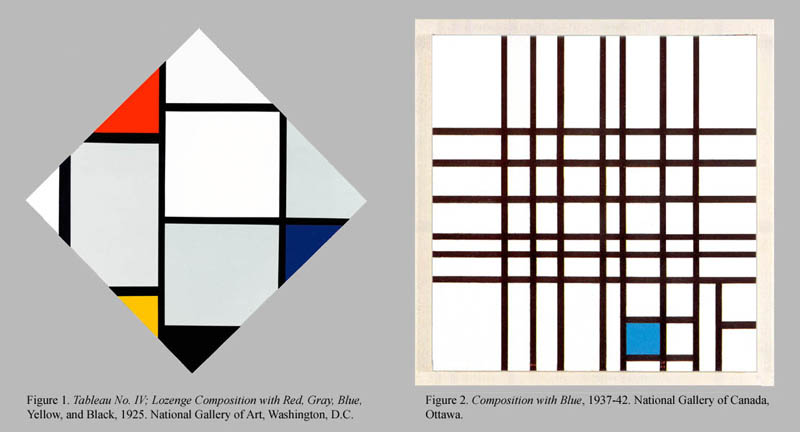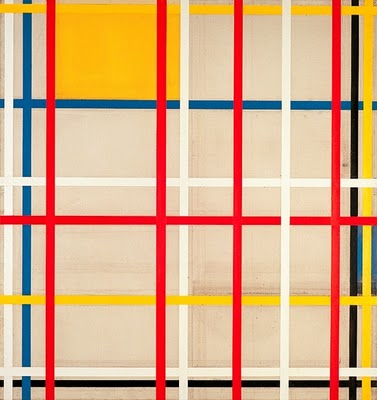“In his The True Value of Oppositions in Life and Art and elsewhere Mondrian argued in favour of trying to reconcile a series of binary oppositions such as good and evil through painting: generally in life we readily perceive oppositions as particular forms,
but we fail to see them as relationships. Yet it is precisely the mutual relationships between the elements themselves that
determine the whole.”

"It is a commonplace about the classic phase of Mondrian's oeuvre that the artist achieves a subtle asymmetrical balance in his compositions. Much of our pleasure in engaging with these works seems to be appreciation of their balance, a balance which provokes our interest and awakens our admiration because it is so challenging. It strikes us not just as asymmetrical, which is not in itself remarkable, but as surprising, eccentric, improbable, even mysterious. The compositions are typically experienced as strong or stable yet also as dynamic, as containing the "equilibrated contrasts"
One of the more interesting of these oppositions which Mondrian worked to harmonize was chaos and order in nature. He tried to do this by isolating some universal underlying structural truth. He said of natural complexity “it is so simple if only one understands a little the great laws that are more or less hidden in natural appearance”
Piet Mondrian’s life was dedicated to style. He was the leader, in fact, of the Dutch-centered De Stijl movement that began during World War I. For Mondrian, the ascetic ideal of De Stijl was renunciation of the physical representation of things. His art was right-angular, asymmetrical, and colored only in the primaries of red, blue and yellow. All lines were straight—for the sake of the spirit. Wrote he: “Natural roundness, in a word, corporeality, gives a purely materialist version of objects.”Mondrian used geometric forms as a metaphor for the order beneath nature,s complexity. Followers of De Stijl designed furniture, built architecture and patterned typography, industrial and household items after its Mondrianesque rules of severity.

"Further, for all their constrictive geometrical parameters – strict rectilinearity and perpendicularity – the works are full of deviations from geometrical regularity that suggest refinements of balance. The "planes" may be strictly rectangular and strictly oriented in the vertical and horizontal, but they almost always deviate from any simple proportionality. With rare exceptions what may appear squares are not in fact equal-sided. A given shape is almost never exactly repeated in a work and the large rectangles are almost never exact multiples of the smaller ones. Diagonals of the rectangles almost never carry on to the corners of other rectangles or to the corners of the support. Nothing ever stands precisely centered in the center."
In the course of his exposition for “De Stijl”, Piet Mondrian ( 1872-1944 ) insisted that the confrontation of the male and female principles clearly displayed the “unity of life and art”. We are entitled, in all likelihood, to take seriously this invitation to unite Mondrian’s life to Mondrian’s art. Had he been anyone else, he would have been just another fussy bachelor, starting affairs he could not consummate, driven back into himself by his awe of female superiority, staring at the provocative nudes in magazines that cater to such tastes: a bank clerk, perhaps, in reality as he was in perspective.

"...in Broadway Boogie Woogie there is a vertical white oblong whose centre coincides precisely with the centre of the square. This is an audacious feature never seen in Mondrian’s earlier work. Having dared to do this in Broadway Boogie Woogie however, Mondrian still manages to avoid the allusion to a mimetic vanishing point through his technique of balancing features eccentrically around the central fulcrum; a sort of lever principle. Lines, colours and shapes are all designed to “pivot” around the centre, perfectly balanced.
A sturdy Dutchman of strict Calvinist origins, he lived like a loner in his Montparnasse studio, where he could rearrange the pure white walls by moving panels about, colored exactly like his art. “To denaturalize is to deepen,” he wrote in 1926, and turned his back on nature. In his quest for the underlying graphs that to him expressed reality, Mondrian became fascinated with the functional artificiality of the machine esthetic. In human terms, this translated into the Charleston… Mondrian so furiously loved the dance that when the Dutch government banned it he refused to return home.

"Composition de lignes et couleur III is a typical example of neo-plastic painting in the de Stijl fashion. It consists of a series of vertical and horizontal lines crossing one another to form a grid. The lines are of varying thickness and are spaced irregularly. In spite of Mondrian’s stated intention to destroy the hierarchy of marks on the canvas, and to provide an “all-over” there remains a natural centre of symmetry to the canvas which is formed notionally by the intersection of the two imaginary diagonals joining the corners of the canvas. All of the shapes in this painting work to balance the whole around this centre point (or around some imaginary line passing through the centre), but without pointing to it in an obvious way."
But fortunately for Mondrian and for art, he was Mondrian, an artist who could transform his neurosis into painting. In 1926, when he heard that the Dutch government had outlawed the Charleston as obscene, Mondrian exploded into an eloquent and revealing protest: “How could they ban that sporting dance! The dancers keep at a certain distance from each other, and spend so much energy in doing the steps that they hardly have time for thoughts of sex. ”
“The rhythmic oscillations of primary colours along the lines of Broadway Boogie Woogie are temptingly close to simulating a musical rhythm, and although Mondrian never played jazz records while painting, modern dancing was a major part of his non-painting life. In the introduction to Mondrian’s essay on Jazz and Neo-plastic Holzman reports a revealing earlier comment on the pr
ct of the Dutch government banning the Charleston dance. Mondrian said in an interview:
Trafalgar Square. 1939–43 Oil on canvas 57 1/4 x 47 1/4" (145.2 x 120 cm) The Museum of Modern Art, New York City
Yes, danced nervously, as it is by Europeans, it often appears hysterical. But with the Negroes, a Josephine Baker, for instance, it is an innate, brilliantly controlled style….The dancers are always so far from each other, and have to work so strenuously, there is no time for amorous thought (Holzman, 1987: 217)
His observation of “brilliant control” in the context of hysteria points clearly to his fundamental life position, which in turn parallels the whole issue of order beneath chaos in nature that his art attempts to reconcile. Perhaps equally interesting is the reference to the “amorous”. The rigorously controlled painting style of mature neo-plastic fairly reeks of repressed or controlled passion. Only in his Boogie-Woogie works is there any real sign of rebellion and overt expression. This is not the place to probe into Mondrian’s sexual practices or repression of them, but perhaps to leave the subject with a quote from Mondrian, on being pressed by another artist to visit a brothel in Paris: “every drop of semen spent is a masterpiece lost” (Collins, 1995)
…Here in these exclamations of protest, we see the prototype of Mondrian’s psychological strategies: sensually disarmed by distance, erotic energy translated into aesthetic activity, an activity so vigorous that one hardly has time for thoughts of sex. As he danced, so he painted. Is there in modern art an instance of sublimation more splendid than this?
To speak of Mondrian’s art as a form of sublimation is to say less than would appear at first glance. Sublimation is not the monopoly of the neurotic or of the artist; it is a universal, perfectly reasonable defense mechanism by which an individual diverts sexual energies from forbidden into permissable channels, or gives these energies an altogether new form. It provides gratification for repressed impulses in ways that are privately acceptable and socially useful. There is a piece of sublimation in all adult activity- in the pursuit of politics , in the conduct of business, in the practice of religion, even in explicitly erotic material.

New York City, 1941-42 Oil on canvas 119 x 114 cm (46 7/8 x 44 7/8 in) Musée National d'Art Moderne, Centre Georges Pompidou, Paris
The artist, as Freud noted long ago, is peculiarly well equipped to sublimate; it may be this gift that directs them towards art in the first place. To diagnose sublimation in art is therefore, by itself, scarcely significant. This is true all the more in that the results of sublimation often bear little resemblance to its origins; to identify its work therefore requires some ingenuity.
Certainly, Mondrian’s sublimation was highly elaborate. Yet at the same time it was peculiarly expressive. It therefore takes a privileged rank among the causes that made his art. Mondrian’s aesthetic choices emerged from his unconscious conflicts; as he translated these choices into his paintings, wielding his ruler and applying his brush, these conflicts guided his hand. He found sensuality so frightening that it was his dread of desire, rather than the desires themselves, that ultimately shaped his abstract designs.
No sentiment, no curves, no touching; that is how he lived and that is what his paintings proclaim. He, like his art, was full of emotions. The equilibrium for which he groped with such patience, such inventiveness, and such needy anxiety, was anything but static. It was, as he himself insisted, dynamic, even if that dynamism had origins of which he was inaware. His paintings offer impressive evidence of just how much beauty the talented can wrest from fear.

During World War II, Mondrian lived in New York, and many critics have detected the city,s restless vitality in such works as Victory Boogie Woogie. Conceived when Mondrian was more than seventy years old, the painting was done in anticipation of Allied victory, indicating that Mondrian was then, as always, an experimenter and an optimist.
If we ask of Mondrian’s paintings , why they are, rather than what they are, psychology must take precedence over stylistics and sociology. The paintings embody Mondrian’s urge to ward off, to omit, to do without, to silence the imperious demands of passions, that, allowed to rise to consciousness, would have been too dangerous to manage, too fearful to face. Painting was, for Mondrian, the aesthetic correlative of his repressions, his way of coming to terms with himself; at once the expression of his problem and an embodiment of his solution. If his famous grids symbolize the sad truth that his only way of life was an ascetic denial of sensuality, they also symbolize, his own private salvation.
“The New York environment, ironically a very particular location, encouraged Mondrian to harmonize more effectively a number of binary oppositions. Modern dance and in particular the boogie-woogie catalysed a most dramatic transition in Piet Mondrian’s painting. It eased him away from the rigidity of the black-lined Euclidean grid underscored by the Calvinistic constraints of his childhood towards a looser and more chaotic use of colour. The patches of colour sidestepped many of the preconceptions associated with black or monochromatic lines, and introduced a rhythmic character within them. The optical linking of colour across the canvas accentuated the dynamic equilibrium by inviting the eye to move obliquely and curvilinearly as well as vertically and horizontally.
Most of Mondrian’s work evolved in small steps, but Broadway Boogie Woogie was a revolutionary step forward, and it had its problems. These included the optical mixing of otherwise pure colour and the return of the dreaded figure ground dichotomy. …Mondrian’s last two paintings showed some evidence of fractal geometry within the canvas, albeit unlike that associated with nature. Instead he intuitively stumbled onto a fractal geometry of man-made space spanning ordered brushstroke and modernist city.






 COMMENTS
COMMENTS